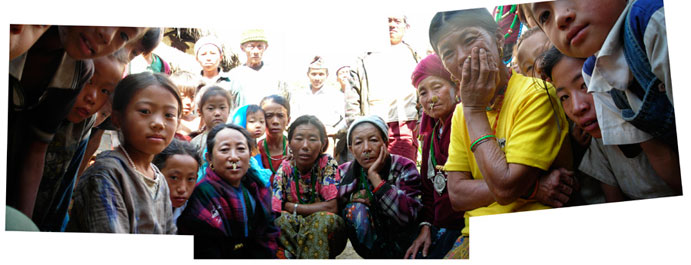
The Nepal Project: Because we were born here . . .
Because We Were Born Here . . . is an ethnographic project currently underway in northeastern Nepal. This 30 year project seeks to document in sound and images, the living history of one Himalayan village as it struggles to 'develop' itself and join the 'modern' world. With the full co-operation of the community, documentary video, photographs, interviews, diaries and other primary source material is being compiled every six years in an effort to promote cultural understanding and education.
The people of the project village are Khulung Rai, one of the 33 ethnic groups that make up Nepal's diverse population. Life in this remote village is blessed by cooperation and simplicity, but complicated by the burdens of isolation and terrain. Daily activities are work centered, punctuated with ceremonies, stories and songs. In contrast to the nationalized Hinduism of Nepal, the Khulung maintain their unique animist religion, their language, and their cultural heritage, but it is not easy. With few natural water sources, no electricity, no roads or healthcare and a limited food supply, the community is eager for development.
What will the future bring? This living history project will continue until 2030, with regular visits and contacts with the community. A documentary film, several publications, and other media will serve to record the difficult decisions and their impact, as this community grows and develops.
Because we were born here . . . was conceived in 1995 while I was working as an Agriculture Extension Agent for His Majesty's Government of Nepal. Like most development workers, I wondered where my efforts were leading and what positive and negative results might come from the development community's plan to "modernize" Nepal. As an experienced filmmaker with a B.F.A. from New York University's film school, my instincts naturally brought me to documentary film. Film is one of the most powerful mediums for compressing time and providing vivid juxtapositions of ideas and action. As Nepal embraces a "western" model of development, this project will record the process of change.
Phase One/2000 launched the project. In February of 2000, I returned to Nepal for five months of shooting in the village of Benchong in Nepal. In addition to 34 hours of digital videotapes (including 17 hours of interviews), more than 200 pages of field notes and drawings, a complete census and photographic record of every villager and household, a random sample survey, 10 personal diaries recorded by teenage boys and girls in the village, 13 essays written by 4th and 5th grade children, audio recording of ceremonies and songs, and more than 500 still photographs were collected.
Phase Two/2006 took place on schedule. In October 2006, I returned to Nepal for three months of shooting in the village. On this trip, I shot more than 30 hours of high-definition video tape, collected hundreds of pages of field notes and continued the census and photographic record of every household in the village. Diaries, school essays, audio recordings and more than 1,000 photographs were also collected.
Phase Three/2012 took place on schedule. In October 2012, I returned to Nepal for five weeks of shooting in the village, the district center and Kathmandu. On this trip I continued to shoot significant hours of high-definition video (yes, I'm still using tape!), collected field notes, nearly 3,000 photos, census data and more. School essays, diaries and household photos were also collected. It is a massive amount of primary data that will produce several documentary films in thirty years, eventually a book, and who knows what else?
Also during this trip, I learned that two of the project participants were in the United Kingdom, living not far from London. In January 2013, shortly after I returned from Nepal, I flew to the UK for and spent two days interviewing and filming this mother and daughter. It was remarkable to see them living in a foreign country far from the remote village where we first met in 1994.
Phase Four will take place in 2018.
On a related note, a welcome, but unexpected Fulbright Fellowship to Nepal in 2001 allowed me to return to the village for ten months in 2001 and 2002. On that trip, I shot no video and instead, focused my attention on the shamanic traditions in Benchong and several surrounding villages. By analyzing the content of individual shamanistic ceremonies, the tradition they were derived from, and the social communities in which they functioned, I worked to discern which aspects of these unique religious rituals were shared collectively, creating a common “vocabulary of shamanism” that transcended ethnic, linguistic, geographic and religious boundaries. In short, I was looking for a blending of Hindu, Buddhist, and animist beliefs among the shamans and their community of followers and lessons that could be learned from any associated cross-cultural communications taking place. You’ll find photos from that research here.
If you're interested in supporting the project with donations or investment, please don't hesitate to contact the project director, Jeffrey Potter by email.
